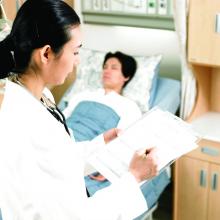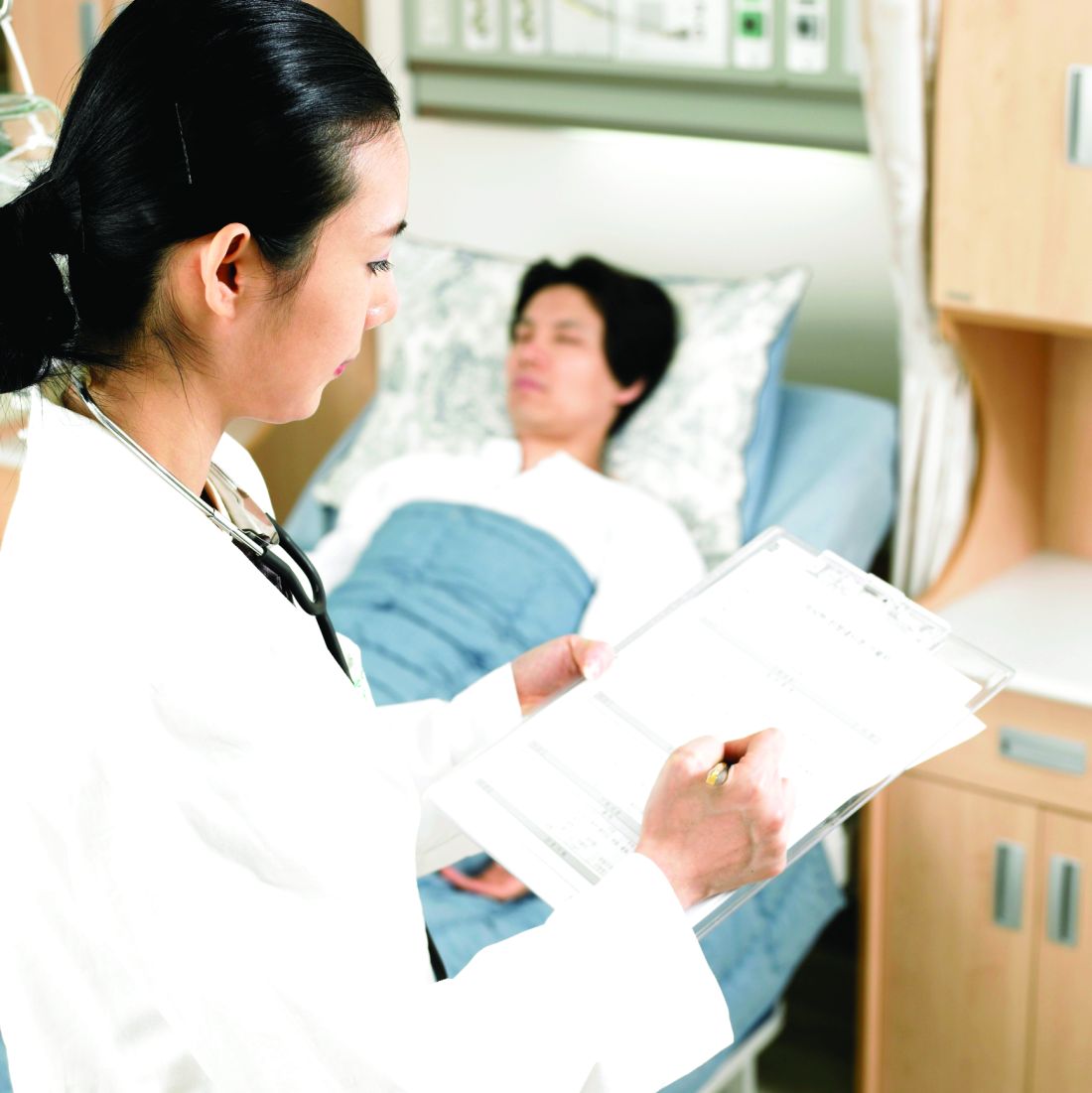User login
according to findings from a study of the British Society for Rheumatology Biologics Register–Rheumatoid Arthritis.
Sujith Subesinghe, MBBS, from the academic department of rheumatology at King’s College London and his coauthors identified 5,289 individuals from the registry who had experienced at least one episode of serious infection. All patients were also on either conventional synthetic disease-modifying antirheumatic drugs (DMARDs) or biologic DMARDs at the time of their index infection.
Serious infections were more likely to occur in individuals who were older, male, seropositive, steroid users, or who had higher baseline Health Assessment Questionnaire scores. The most common type of serious infection was respiratory, which accounted for 44% of all events.
Overall, recurrent infections tended to occur in the same organ as index infections. Patients who experienced sepsis as the index infection had the highest risk of recurrent serious infection of 19.7% per annum, representing a 32% increased risk for recurrent serious infection, compared with individuals whose index infection was in the respiratory tract. Patients whose initial infection was musculoskeletal or gastrointestinal had a recurrence rate below 10%.
“It has been shown previously that a history of SI [serious infection] is a strong predictor of subsequent SI, but what has not been shown before is that the organ class of the index event has a large impact on the likelihood of recurrent SI,” the authors wrote.
Each decade of increased age was associated with a 34% increase in risk of recurrent infection. Noting that multiple drug use was a surrogate measure of comorbidity at baseline, researchers found that individuals taking 6-10 drugs at baseline had a 26% increased risk for recurrent infection, while those treated with 11 or more drugs had a 74% increased risk.
The authors observed that baseline steroid use was higher among patients suffering sepsis, compared with other types of serious infection.
They observed that, although a strong association between serious infection and steroid use has been reported, no firm conclusions have been reached by systematic reviews or meta-analyses “Steroids are more likely to be prescribed to patients with more aggressive, recalcitrant disease; this group has a higher baseline infection risk, and therefore, there is potential for confounding by indication.”
However, baseline disease activity score, disease duration, seropositivity, and smoking did not significantly predict the likelihood of infection recurrence, despite the fact that these are traditional predictors of infection. The authors suggested this may be the result of a form of selection bias.
“Patients readmitted with SI were from an already at-risk group and therefore lack of association between traditional predictors of infection and recurrent SI may be spurious.”
Commenting on their findings, the authors observed that individuals with rheumatoid arthritis and a history of infection were a complex group to manage, and even small differences in relative infection risk with different biologics may become significant.
“Further research needs to be undertaken to understand the patterns of recurrent infection and to appreciate the nuances in differential infection profiles of immunosuppressive drugs, to promote safe therapeutic decisions and promote personalization of care.”
The study was supported by the British Society for Rheumatology. Two authors declared speaking fees or honoraria from the pharmaceutical industry.
SOURCE: Subesinghe S et al. Rheumatology [Oxford]. 2018 Jan 10. doi: 10.1093/rheumatology/kex469.
according to findings from a study of the British Society for Rheumatology Biologics Register–Rheumatoid Arthritis.
Sujith Subesinghe, MBBS, from the academic department of rheumatology at King’s College London and his coauthors identified 5,289 individuals from the registry who had experienced at least one episode of serious infection. All patients were also on either conventional synthetic disease-modifying antirheumatic drugs (DMARDs) or biologic DMARDs at the time of their index infection.
Serious infections were more likely to occur in individuals who were older, male, seropositive, steroid users, or who had higher baseline Health Assessment Questionnaire scores. The most common type of serious infection was respiratory, which accounted for 44% of all events.
Overall, recurrent infections tended to occur in the same organ as index infections. Patients who experienced sepsis as the index infection had the highest risk of recurrent serious infection of 19.7% per annum, representing a 32% increased risk for recurrent serious infection, compared with individuals whose index infection was in the respiratory tract. Patients whose initial infection was musculoskeletal or gastrointestinal had a recurrence rate below 10%.
“It has been shown previously that a history of SI [serious infection] is a strong predictor of subsequent SI, but what has not been shown before is that the organ class of the index event has a large impact on the likelihood of recurrent SI,” the authors wrote.
Each decade of increased age was associated with a 34% increase in risk of recurrent infection. Noting that multiple drug use was a surrogate measure of comorbidity at baseline, researchers found that individuals taking 6-10 drugs at baseline had a 26% increased risk for recurrent infection, while those treated with 11 or more drugs had a 74% increased risk.
The authors observed that baseline steroid use was higher among patients suffering sepsis, compared with other types of serious infection.
They observed that, although a strong association between serious infection and steroid use has been reported, no firm conclusions have been reached by systematic reviews or meta-analyses “Steroids are more likely to be prescribed to patients with more aggressive, recalcitrant disease; this group has a higher baseline infection risk, and therefore, there is potential for confounding by indication.”
However, baseline disease activity score, disease duration, seropositivity, and smoking did not significantly predict the likelihood of infection recurrence, despite the fact that these are traditional predictors of infection. The authors suggested this may be the result of a form of selection bias.
“Patients readmitted with SI were from an already at-risk group and therefore lack of association between traditional predictors of infection and recurrent SI may be spurious.”
Commenting on their findings, the authors observed that individuals with rheumatoid arthritis and a history of infection were a complex group to manage, and even small differences in relative infection risk with different biologics may become significant.
“Further research needs to be undertaken to understand the patterns of recurrent infection and to appreciate the nuances in differential infection profiles of immunosuppressive drugs, to promote safe therapeutic decisions and promote personalization of care.”
The study was supported by the British Society for Rheumatology. Two authors declared speaking fees or honoraria from the pharmaceutical industry.
SOURCE: Subesinghe S et al. Rheumatology [Oxford]. 2018 Jan 10. doi: 10.1093/rheumatology/kex469.
according to findings from a study of the British Society for Rheumatology Biologics Register–Rheumatoid Arthritis.
Sujith Subesinghe, MBBS, from the academic department of rheumatology at King’s College London and his coauthors identified 5,289 individuals from the registry who had experienced at least one episode of serious infection. All patients were also on either conventional synthetic disease-modifying antirheumatic drugs (DMARDs) or biologic DMARDs at the time of their index infection.
Serious infections were more likely to occur in individuals who were older, male, seropositive, steroid users, or who had higher baseline Health Assessment Questionnaire scores. The most common type of serious infection was respiratory, which accounted for 44% of all events.
Overall, recurrent infections tended to occur in the same organ as index infections. Patients who experienced sepsis as the index infection had the highest risk of recurrent serious infection of 19.7% per annum, representing a 32% increased risk for recurrent serious infection, compared with individuals whose index infection was in the respiratory tract. Patients whose initial infection was musculoskeletal or gastrointestinal had a recurrence rate below 10%.
“It has been shown previously that a history of SI [serious infection] is a strong predictor of subsequent SI, but what has not been shown before is that the organ class of the index event has a large impact on the likelihood of recurrent SI,” the authors wrote.
Each decade of increased age was associated with a 34% increase in risk of recurrent infection. Noting that multiple drug use was a surrogate measure of comorbidity at baseline, researchers found that individuals taking 6-10 drugs at baseline had a 26% increased risk for recurrent infection, while those treated with 11 or more drugs had a 74% increased risk.
The authors observed that baseline steroid use was higher among patients suffering sepsis, compared with other types of serious infection.
They observed that, although a strong association between serious infection and steroid use has been reported, no firm conclusions have been reached by systematic reviews or meta-analyses “Steroids are more likely to be prescribed to patients with more aggressive, recalcitrant disease; this group has a higher baseline infection risk, and therefore, there is potential for confounding by indication.”
However, baseline disease activity score, disease duration, seropositivity, and smoking did not significantly predict the likelihood of infection recurrence, despite the fact that these are traditional predictors of infection. The authors suggested this may be the result of a form of selection bias.
“Patients readmitted with SI were from an already at-risk group and therefore lack of association between traditional predictors of infection and recurrent SI may be spurious.”
Commenting on their findings, the authors observed that individuals with rheumatoid arthritis and a history of infection were a complex group to manage, and even small differences in relative infection risk with different biologics may become significant.
“Further research needs to be undertaken to understand the patterns of recurrent infection and to appreciate the nuances in differential infection profiles of immunosuppressive drugs, to promote safe therapeutic decisions and promote personalization of care.”
The study was supported by the British Society for Rheumatology. Two authors declared speaking fees or honoraria from the pharmaceutical industry.
SOURCE: Subesinghe S et al. Rheumatology [Oxford]. 2018 Jan 10. doi: 10.1093/rheumatology/kex469.
FROM RHEUMATOLOGY
Key clinical point: Recurrent serious infections are relatively common among individuals with RA, particularly in the first year after an initial serious infection.
Major finding: The baseline annual rate of serious infections in patients with RA increased to 14.1% after having infection.
Data source: Analysis of data from 5,289 individuals from the British Society for Rheumatology Biologics Register–Rheumatoid Arthritis cohort.
Disclosures: The study was supported by the British Society for Rheumatology. Two authors declared speaking fees or honoraria from the pharmaceutical industry.
Source: Subesinghe S et al. Rheumatology [Oxford]. 2018 Jan 10. doi: 10.1093/rheumatology/kex469.

